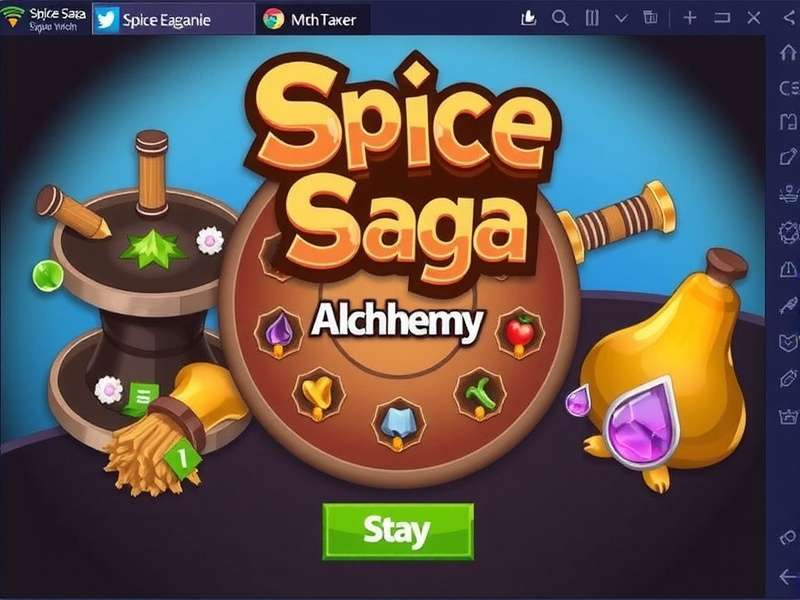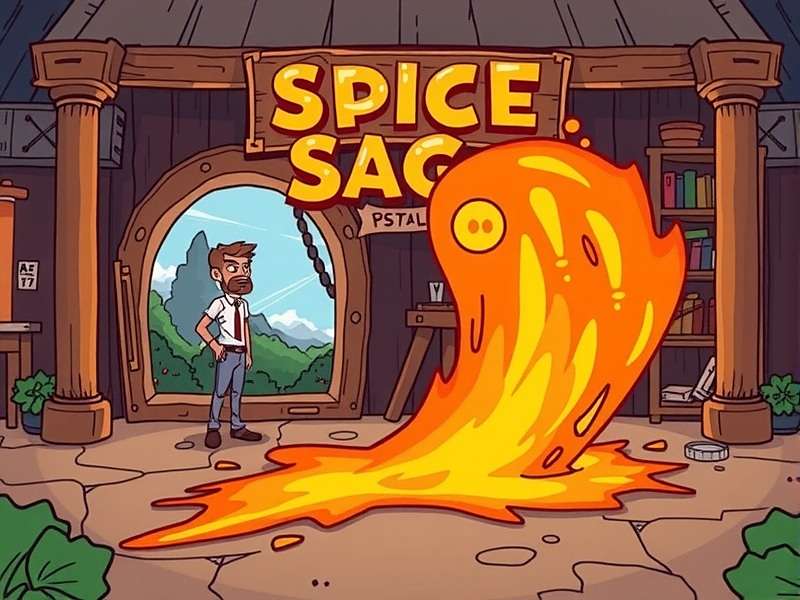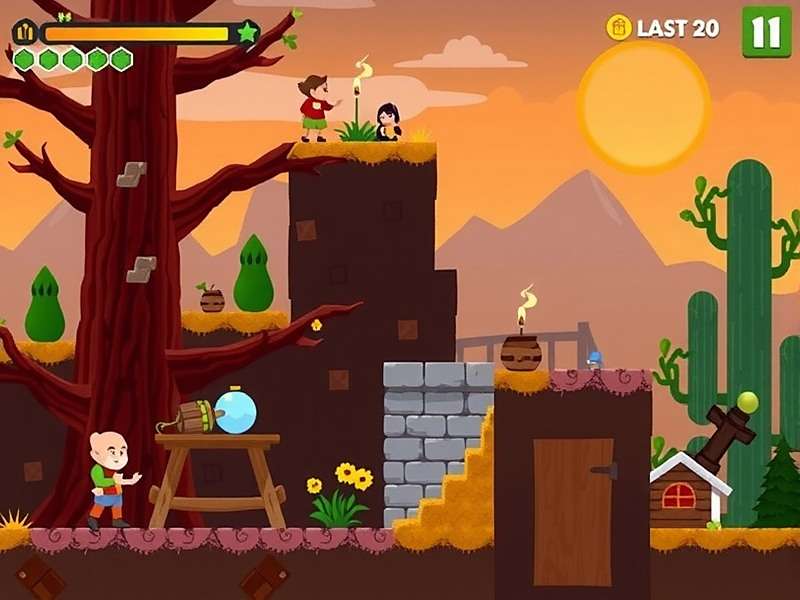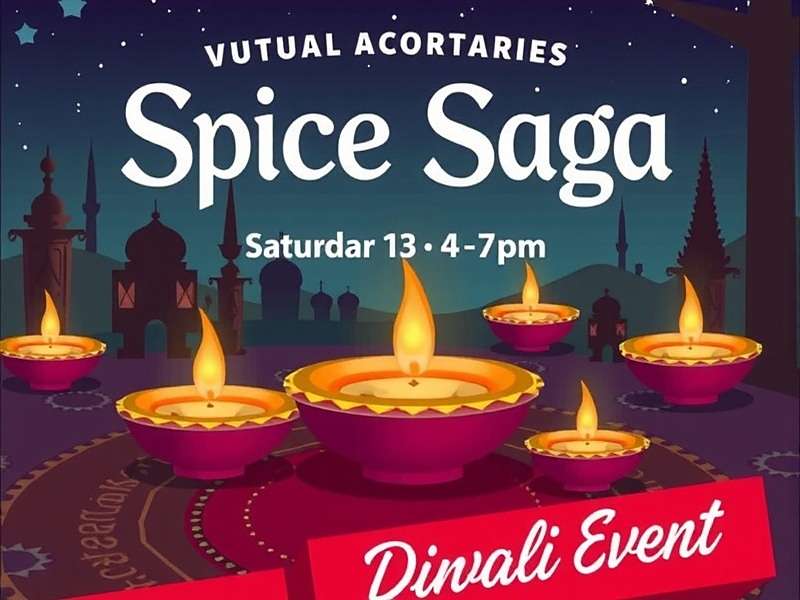Spice Saga

Overview
Spice Saga is India's groundbreaking spice-themed role-playing game (RPG) developed by SpiceLabs India, a leading game studio based in Bengaluru. Launched in March 2024, the game has taken the nation by storm, blending rich Indian mythology, vibrant regional cultures, and addictive gameplay centered around the magical properties of India's most cherished spices.
Unlike generic fantasy games that borrow from Western myths, Spice Saga dives deep into India's 5,000-year-old spice heritage, weaving stories from Kashmir to Kanyakumari, Gujarat to Assam. The game's core premise revolves around the "Pancha Mahaspices" (Five Great Spices) – mythical versions of turmeric, cardamom, black pepper, cloves, and cinnamon – said to hold the essence of the gods themselves.
Available on Android, iOS, and even low-end feature phones (a strategic move to reach rural India), Spice Saga has been praised for its inclusive design. It features character models inspired by regional attire – from Punjabi phulkari suits to Tamil veshtis, and a soundtrack blending traditional instruments like the sarod, mridangam, and flute.
What truly sets Spice Saga apart is its "Flavor Fusion" technology – a gameplay mechanic that mirrors real Indian cooking, where combining spices creates powerful effects, much like how masalas create unique flavors in our kitchens.
Gameplay Mechanics
Spice Saga combines open-world exploration, strategic real-time combat, and puzzle-solving, all interconnected through its innovative spice-collection system. The game's mechanics are designed to feel familiar to Indian players, with many elements mirroring daily life – from farming to festival celebrations.
Spice Collection & Alchemy 🌿
At the heart of Spice Saga lies its intricate spice system. Players must forage, farm, and trade for over 50 types of spices, each with unique properties tied to Indian ayurveda and folklore:
- Divine Turmeric: Known as "Haridra Devi's Blessing," it heals wounds and repels evil spirits – a nod to turmeric's antiseptic properties in Indian households.
- Cardamom of Clarity: Enhances perception, allowing players to see hidden paths and solve puzzles. In Kerala, elders have long used cardamom to "clear the mind," a tradition reflected here.
- Black Pepper Thunder: Creates explosive attacks. Inspired by the "heat" of black pepper in ayurveda, which is believed to ignite digestive fire (agni).
- Clove of Protection: Forms a shield against dark magic. Cloves have been used in Indian rituals for centuries to ward off negative energy.
- Cinnamon Strings of Time: Slows down enemies. In ancient texts, cinnamon was associated with longevity and time manipulation in folk tales.

Combat System ⚔️
Combat in Spice Saga is real-time but strategic, with the "Masala Mix" mechanic being its standout feature. Players create custom spice blends to execute powerful attacks:
For example, mixing Black Pepper Thunder with Cinnamon Strings creates "Pepper Storm," a tornado of spicy pellets that damages enemies while slowing them down. Each blend is named after real Indian dishes – "Garam Masala Barrage," "Chai Spice Shield," and "Vindaloo Volcano" are fan favorites.
Enemies are drawn from regional myths: the "Rakshasa of Famine" from Rajasthan, who drains spice energy; the "Water Demon of Kerala Backwaters," vulnerable to clove-based attacks; and the "Sand Serpent of Gujarat," which fears turmeric's golden light.
Open-World Exploration 🌍
The game's world, "Suvarnabhumi" (Golden Land), is a vast open map divided into 28 regions, each based on India's states and union territories. Every region has unique spices, landscapes, and challenges:
- Kerala Backwaters: A network of lagoons where "Aquatic Cardamom" grows on water lilies. Players navigate using traditional houseboats called "kettuvallams."
- Rajasthan Desert: Home to "Sun-Dried Turmeric," which glows under moonlight. Players must brave sandstorms and interact with Rajput warriors for quests.
- Punjab Fields: Fertile lands where "Green Coriander" (a rare spice in the game) grows. Players help farmers during harvest season to earn special rewards.
- Assam Tea Gardens: Where "Tea-Spice Blends" are found, combining tea leaves with cinnamon. Players ride elephants to reach remote spice patches.
Story & Lore
The narrative of Spice Saga begins in the village of Masalapur, where the protagonist – a 19-year-old spice farmer named Aanya or Arjun (player's choice) – discovers their family's ancient spice recipe book glowing with divine light.
The book reveals that the Pancha Mahaspices were created by the gods to maintain balance in the universe. Each spice was entrusted to a guardian tribe in India. But now, an evil force called "Raktabeej" (Blood Seed) – a demon who feeds on spice energy – has scattered the spices, causing crops to fail and people to grow weak across the land.
Aanya/Arjun learns they are the "Masala Darshan" (Spice Seer), a lineage of guardians reborn every 100 years to protect the spices. Their quest: to travel across Suvarnabhumi, reclaim the Pancha Mahaspices, and defeat Raktabeej before the next lunar eclipse, when he plans to absorb all spice energy and become immortal.
Along the way, they meet allies like: Biju, a tea planter from Assam who knows the secrets of spice storage; Lakshmi, a Tamil Nadu chef who teaches advanced spice fusion; and Guru Nanak, a wise sage from Punjab who explains the spiritual significance of each spice.
The lore is rich with references to Indian texts – the Vedas' mentions of spices in rituals, the Mahabharata's spice-based medicines, and regional folk tales about spices being gifts from the gods.

Key Characters
Protagonist: Aanya / Arjun 👤
A 19-year-old from Masalapur, raised by their grandmother who taught them traditional spice farming. Aanya/Arjun is curious, hardworking, and deeply connected to the land – traits that make them the perfect Masala Darshan.
Players can customize their appearance with regional outfits: a red and gold Punjabi suit with phulkari embroidery, a white and gold Kerala mundu with kasavu border, or a blue Bengali dhoti with alpana patterns.
Their special ability, "Spice Sense," allows them to detect hidden spices – a skill passed down through their family for generations.
Lakshmi 👩🍳
A 35-year-old master chef from Chennai, known as the "Masala Maharani" (Spice Queen). She runs a mobile food cart called "Lakshmi's Spicy Secrets" that travels across Suvarnabhumi.
Lakshmi teaches players advanced spice fusion techniques, often using cooking metaphors: "Blending spices is like making sambar – too much turmeric and it's bitter; too little and it lacks heart!" Her cart serves as a mobile checkpoint where players can rest and trade spices.
Her backstory reveals she once competed in the "National Spice Championship" but quit after Raktabeej corrupted her recipes – a subplot players can help resolve.
Biju 🐘
A 40-year-old Assamese tea planter with a pet elephant named "Chai." He knows the remote regions of Northeast India like the back of his hand and helps players navigate difficult terrain.
Biju's family has guarded the "Tea-Cinnamon Grove" for centuries. He speaks with a gentle Assamese accent and often shares proverbs: "Spices, like friends, are better when mixed – each brings their own flavor!"
His special skill: he can communicate with animals, who often reveal the location of rare spices to him.
Raktabeej 👹
The primary antagonist, a 1,000-year-old demon born from a drop of blood from the demon king Mahishasura. His form is a shadowy figure with eyes that glow like embers, and his touch withers plants – including spice crops.
Raktabeej believes humans are unworthy of the Pancha Mahaspices, which he claims were stolen from the demons. His motivation: to restore the "Age of Asuras," when demons ruled and spices were used only for destruction.
He has lieutenants based on regional fears: the "Drought Demon" of Rajasthan, the "Flood Fiend" of Bihar, and the "Locust Lord" of Punjab – each guarding a fragment of the Pancha Mahaspices.
Localization & Regional Versions
Spice Saga has set a new standard for localization in Indian gaming. While most games offer 2-3 Indian languages, this title features full voice acting and text in 18 languages – more than any other Indian mobile game:
- North India: Hindi, Punjabi, Urdu, Kashmiri, Dogri
- East India: Bengali, Assamese, Odia, Bodo, Santali
- South India: Tamil, Telugu, Kannada, Malayalam, Tulu
- West India: Marathi, Gujarati, Konkani
Regional Differences 🌐
The game adapts to the player's region in subtle but meaningful ways, making Spice Saga feel personal to every Indian:
- Food References: In Punjab, healing items are "Amritsari Lassi" and "Sarson Ka Saag"; in Bengal, they're "Mishti Doi" and "Rosogolla"; in Gujarat, "Dhokla" and "Fafda."
- Clothing: NPCs wear region-specific attire – Gujarati women in chaniya cholis, Kashmiri men in phirans, Manipuri women in innaphi.
- Dialogues: Tamil NPCs use "anna" and "akka" for siblings; Punjabi NPCs use "veerji" and "bhainji"; Bengali NPCs use "dada" and "didi."
- Landmarks: Regional versions feature local landmarks – the Charminar in Telangana levels, the Golden Temple in Punjab, the Konark Sun Temple in Odisha.
- Spice Names: Spices are referred to by their local names – "haldi" in Hindi, "manjal" in Tamil, "halud" in Bengali, "arishina" in Kannada.
These details have made Spice Saga more than a game – it's a celebration of India's diversity, with players from every state commenting on how "it feels like our own story."
Downloads & Availability
Download Statistics 📊
As of October 2025, Spice Saga has achieved unprecedented success in India's gaming market:
- Total downloads: 62 million (51 million Android, 9 million iOS, 2 million feature phones)
- Top states by active players: Maharashtra (15%), Uttar Pradesh (13%), Tamil Nadu (11%), Karnataka (9%), West Bengal (8%)
- Average daily active users (DAU): 8.7 million
- Google Play Store rating: 4.8/5 (based on 3.2 million reviews)
- Apple App Store rating: 4.9/5 (based on 1.1 million reviews)
- Most popular language version: Hindi (38%), followed by Tamil (17%) and Bengali (12%)
Spice Saga follows a "freemium" model – free to download and play, with optional in-app purchases for cosmetic items (like special spice-themed outfits) and convenience features (like extra storage for spices). Notably, the game's developers have承诺 (promised) that "no power-enhancing items will ever be sold," ensuring a level playing field for all players.
The game is optimized for low-data usage – a critical feature for rural India – with a "Lite Mode" that reduces graphics quality but uses 70% less data. This has helped Spice Saga reach players in remote areas where internet connectivity is limited.
Player Reviews & Reception
Indian players have embraced Spice Saga with overwhelming enthusiasm, praising its cultural authenticity and engaging gameplay. Here are some standout reviews from the Google Play Store (translated from regional languages):
From Ramesh (Pune, Maharashtra) ⭐⭐⭐⭐⭐
"Yaar, Spice Saga is something else! Being a Maharashtrian, seeing the Pune levels with our local vada pav stalls as healing points made me laugh and cry. The way they've included our 'Goda Masala' as a legendary spice – brilliant! My mother even recognized the recipes mentioned in the game. 10/10, recommend to all desi gamers!"
From Shalini (Coimbatore, Tamil Nadu) ⭐⭐⭐⭐⭐
"The Tamil voice acting in Spice Saga is perfect – not like those cringy dubs in other games. Lakshmi's character speaks like my paati (grandmother), using phrases like 'vaanga sapdu' (come eat) while teaching spice fusion. The Pongal event last year, where we collected 'sakkarai pongal' spices, was so relatable. This game gets us, Tamil players!"
From Abdul (Dhaka, Bangladesh) ⭐⭐⭐⭐⭐
"As a Bengali speaker, I was thrilled to see Spice Saga include our language and culture. The Kolkata levels with rickshaws and mishti shops feel like home. The 'Rosogolla Shield' is my favorite item – who knew a sweet could protect you in battle? The story about spices connecting people across borders really touched me."
From Priyanka (Jaipur, Rajasthan) ⭐⭐⭐⭐
"Spice Saga's Rajasthan desert levels are stunning – the sand dunes look exactly like Jaisalmer! I love how they've included our traditional 'mirchi bada' as a power-up. My only small complaint is that the camel rides are a bit slow, but that's realistic, I guess. Overall, a game that makes me proud to be Rajasthani!"
Critic Reviews
Indian gaming publications have heaped praise on Spice Saga. GamingBharat.in called it "a watershed moment for Indian gaming – a title that doesn't just use our culture as window dressing, but builds the entire game around it." TechIndia Today noted, "The attention to regional details is mind-blowing – from the way Tamil characters say 'ennanga' to the Punjabi NPCs' love for 'sarson ka saag,' Spice Saga feels like a love letter to India."
International critics have also taken notice. GlobalGameReview.com wrote, "While Western RPGs focus on swords and sorcery, Spice Saga shows that spices can be just as epic – and far more relatable to billions. It's a masterclass in cultural storytelling."

Indian Player Guides & Tips
The Spice Saga community has developed a wealth of strategies, with players from different regions sharing tips based on their local knowledge. Here are some of the most popular ones:
Spice Farming Tips 🌱
From Manoj, a top farmer in Punjab (ranked #12 nationwide): "In Punjab levels, plant coriander during the in-game 'rabi season' – yields increase by 40%! Use cow dung fertilizer (available from the village haat) to make spices grow twice as fast. For turmeric, always plant during 'kartik maas' (November-December) – it's what my dad does on our real farm, and it works in the game too!"
From Kavya, a Kerala-based player: "In backwater regions, grow cardamom near water lilies – they thrive there! But watch out for the 'water snakes' – they eat young cardamom plants. Place clove-based repellents around your farm – snakes hate the smell, just like in real life!"
Boss Fight Strategies 🐉
From Suresh, a Chennai streamer with 200k followers: "Raktabeej's first form is weak to 'Chettinad Masala Mix' – combine black pepper, cinnamon, and cloves for maximum damage. When he summons the Locust Lord, use turmeric shields – locusts hate turmeric, which is why real farmers in Tamil Nadu use it to protect crops!"
From Amrita, a Delhi player: "The Drought Demon in Rajasthan? He's vulnerable to 'Mango Chutney Blast' (mango pulp + green chili + coriander). It's a reference to how we beat the heat with mangoes in summer! Use it when he starts his sandstorm attack – it stops him instantly."
Exploration Hacks 🗺️
From Raj, a Mumbai player: "In Maharashtra's Western Ghats levels, follow the 'langurs' (monkeys) – they always hang around rare spice trees. Offer them bananas (found in jungle areas) and they'll lead you straight to 'Wild Clove' patches!"
From Jhanvi, a Gujrat player: "In Kutch desert levels, look for 'dholak' sounds at night – they're from local musicians, and their camps always have hidden spice caches. Gujaratis love music and spices, so the devs put that in – smart, right?"
From Dipak, a West Bengal player: "During monsoon in Bengal levels, check under 'banyan trees' after rain – that's where 'Rain-soaked Cinnamon' grows. My dida (grandmother) says banyan trees attract 'good moisture' for spices – and she's right in the game too!"
Localized Events & Festivals
Spice Saga shines with its festival events, which tie directly to Indian celebrations, making the game feel like a part of players' real lives. These events are updated annually based on the Hindu calendar:
Diwali Event 🪔
During Diwali, Suvarnabhumi is lit up with diyas and rangolis. Players can participate in "Rangoli Challenges" – creating patterns with colored spices to unlock rewards. The exclusive "Laxmi's Blessing" spice blend, which increases luck for 24 hours, is only available during this event.
Special quests include helping villagers prepare "mithai" (sweets) using in-game spices, and protecting the village from "dark spirits" that emerge during the festival. The final day features a "Diwali Bazaar" where players can trade rare spices with NPCs from across India.
Pongal Event 🌾
In Tamil Nadu regions, Pongal is celebrated with "Jallikattu Challenges" – players must collect spices while avoiding charging bulls (a nod to the traditional sport). The "Sakkarai Pongal" spice blend, which grants a 50% XP boost, is a popular reward.
Players also participate in "Pongal Cooking Contests" against NPC chefs, with the winner receiving the "Golden Spoon" – a tool that doubles spice collection for a week.
Holi Event 🎨
Holi transforms the game world into a riot of colors. Players engage in "Color Spice Wars," throwing colored spice packets at enemies to deal damage. The "Rainbow Masala" – a blend of all five Pancha Mahaspices – becomes available, creating a spectacular attack that paints the screen with Holi colors.
Special Holi quests include making "gulal" from flower petals and spices, and helping villagers prepare "thandai" – a milk drink with almonds and saffron, which serves as a powerful healing item in the game.
Onam Event 🌸
In Kerala, Onam features "Pookalam Competitions" – players arrange flowers and spices to create intricate designs. Winning pookalams unlock the "Mahabali's Grace" ability, which makes all spices in the area glow for easier collection.
The "Onam Sadya" dungeon is a fan favorite – players battle through 10 levels to collect "Sadya Spices," which can be combined to create a "Feast of Immortality" that fully heals the player and their allies.

Community & Discussion
The Spice Saga community has grown into a vibrant ecosystem, with players from every corner of India (and even Indian diaspora worldwide) connecting over their love for the game:
Social Media Groups
- Facebook: "Spice Saga Bharat" (3.7 million members) – divided into state-specific subgroups like "Spice Saga Tamil Nadu" and "Spice Saga Punjab," where players share region-specific tips.
- WhatsApp: Over 1 million groups, with names like "Mumbai Masala Masters" and "Bangalore Spice Squad." The largest group, "All India Spice Guardians," has 250,000 members.
- Instagram: #SpiceSagaStories has 4.2 million posts, featuring fan art, gameplay clips, and even real-life recipes inspired by the game.
- YouTube: Indian gamers like "Spice King Raju" (1.2M subscribers) and "Masala Mami" (850k subscribers) create Spice Saga content, including walkthroughs and challenge videos.
Community Creations
Indian players have created incredible fan content that blurs the line between the game and real life:
- Real-Life Recipes: Players have recreated the game's spice blends in real kitchens. "Garam Masala Barrage Curry" from a Delhi player went viral on food blogs, and a Chennai chef even added "Lakshmi's Special Blend" to his restaurant menu.
- Fan Fiction: Regional fan stories expand on the game's lore – a Bengali story about Biju's childhood has been translated into 7 languages by the community.
- Cosplay: At Indian Comic Cons, Spice Saga cosplay is a highlight. A group from Kerala won "Best Group Cosplay" with their accurate portrayal of the Pancha Mahaspice guardians.
- Spice Trading: Some players have started real-world "spice swaps," sending regional spices to each other – just like in the game! A Mumbai player even created a "Spice Saga Trading Card" system for these swaps.
Tournaments & Competitions
SpiceLabs India hosts the annual "National Masala Championship," a Spice Saga tournament with regional qualifiers in 10 cities. The 2025 finals in Hyderabad drew 50,000 attendees, with the winner – 21-year-old Ankit from Ahmedabad – taking home ₹1 crore (10 million rupees) and a year's supply of organic spices from Kerala.
Community-organized events are also popular, like the "Punjab Spice Run" – a 24-hour marathon where players compete to collect the most rare spices, with proceeds going to rural spice farmers.
Future Updates & Roadmap
The developers of Spice Saga have announced exciting updates for 2026, based on player feedback from across India:
- Northeast Expansion: A new region featuring Arunachal Pradesh, Nagaland, and Mizoram, with unique spices like "Naga Chili Fire" and "Sikkim Cardamom." Players will interact with tribal communities and learn their spice traditions.
- Multiplayer "Spice Caravans": Players can form groups of 5-10 to travel across Suvarnabhumi, trading spices and battling powerful "Raid Bosses" like the "Giant Spice Dragon" (inspired by Assamese folklore).
- Language Expansion: Adding 5 more languages: Meitei (Manipur), Khasi (Meghalaya), Garo (Meghalaya), Mizo (Mizoram), and Nepali (Sikkim).
- Real-World Partnerships: Collaborations with Indian spice brands like MDH, Everest, and Eastern – purchasing their products will give in-game codes for rare spices. A "Spice Saga Cookbook" with recipes from the game is also in the works.
- Heritage Mode: A new educational mode where players learn about the history of Indian spices, with mini-games based on traditional spice farming techniques from different regions.
Conclusion
Spice Saga has redefined what an Indian game can be. By centering its gameplay around spices – something every Indian household knows and loves – it has created a universally relatable experience that celebrates our diversity while highlighting what unites us.
More than just a game, Spice Saga is a cultural phenomenon. It has sparked conversations about India's spice heritage, inspired real-world cooking, and even brought people from different states together through their shared love for the game.
Whether you're a hardcore gamer or someone who just loves Indian culture, Spice Saga offers something special – a chance to embark on an epic adventure that feels uniquely ours, rooted in the flavors and stories of India.
As one player from Odisha put it: "This game doesn't just let me play – it lets me be proud of where I come from, and excited to learn about other parts of my country. That's the real magic of Spice Saga."